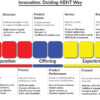
“Investing is like a game of chess. You have to plan several moves ahead. But unlike chess, in investing, you can’t see all the pieces on the board.” – Peter Lynch
In the grand chessboard of the stock market, where fortunes are made and lost, Peter Lynch reigns as a legendary kingmaker. His 13-year run managing the Magellan Fund, delivering an annualized return of 29.2%, stands as a testament to his genius. Among his many valuable insights, perhaps none shines brighter than Rule 10: Capital Allocation is King.
Investing isn’t just about finding great companies; it’s about finding those that know how to turn money into magic. Just like a skilled magician, companies can make even modest resources disappear and reappear as a dazzling portfolio of success. This magical trick of efficient capital allocation is where ROIC (Return on Invested Capital) steps in, becoming the wand that makes your portfolio flourish.
Why ROIC Matters:
ROIC measures how effectively a company uses its invested capital to generate profits. It goes beyond simple measures like earnings per share by factoring in how much capital was actually used to achieve those earnings. A high ROIC indicates that the company is squeezing every drop of value out of its investments, like a shrewd alchemist transforming lead into gold.
Lynch on ROIC:
“My favorite statistic is return on equity. Not because it’s a perfect measure, but because it forces you to think about how much profit a company earns on the money it has. Every time I hear a stock has a P/E of 60, I ask myself, ‘Does the company even earn 60% on its assets?’ If not, I steer clear.” – Peter Lynch

Decoding the ROIC Signal:
- Look for ROIC consistently above the cost of capital: As a gold standard, aim for companies with ROIC exceeding their weighted average cost of capital (WACC). This ensures they’re generating returns above what it costs them to borrow money.
- Compare within industries: Not all industries have the same average ROIC. Understand the typical range for your target sector and prioritize companies exceeding those benchmarks.
- Beware of declining ROIC: A consistently falling ROIC could indicate deteriorating capital allocation skills or underlying business challenges. Investigate further before investing.
Pro Tips for Capital Allocation Champions:
- Seek companies with clear and consistent capital allocation strategies: Look for management with a proven track record of deploying capital into profitable ventures, avoiding wasteful expenditures.
- Favour reinvestment over excessive dividends: Companies that reinvest a significant portion of their profits tend to grow faster and generate superior long-term returns.
- Be wary of debt-fuelled growth: While leveraging can accelerate growth, excessive debt can also burden a company and lead to trouble if profits falter.
Remember:
ROIC is not a standalone magic spell. It’s a crucial piece in the puzzle of successful investing. Combine it with thorough company research, sound financial analysis, and a long-term vision, and you’ll be well on your way to cracking the “Peter Lynch” code and beating the markets.
So, step onto the chessboard, pick up your ROIC wand, and make your move! Let capital allocation be your guiding light, and watch your portfolio blossom under the magic touch of long-term success.
Guiding Books and Resources:
- One Up on Wall Street by Peter Lynch: Lynch’s investment bible, packed with practical tips and his signature blend of humor and wisdom.
- Capital Allocation: How Value-Creating Companies Spend Their Money by Michael J. Mauboussin: A deep dive into the art of capital allocation, exploring how the best companies make the most of their resources.
- The Outsiders by William N. Thorndike: Uncovers the stories of successful companies built on the foundation of prudent capital allocation.
Prof. Dr. Prahlada N. B
13 January 2023
Chennai.

















Leave a reply